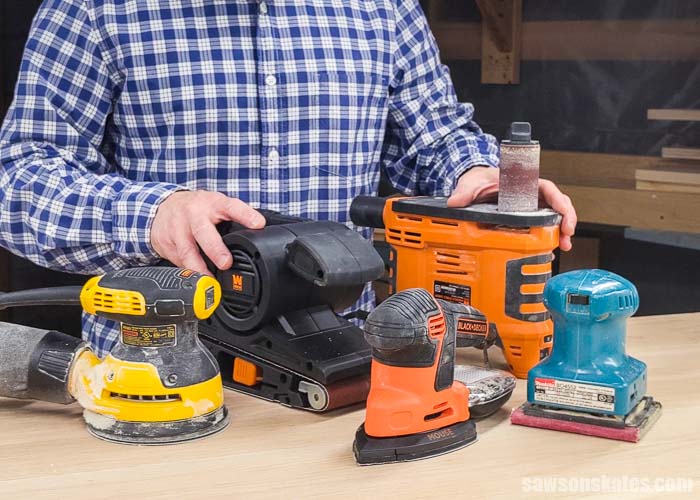Have you ever wondered if an orbital sander is good for furniture? Well, you’re in the right place! In this article, we’ll explore the benefits and applications of using an orbital sander for your furniture projects.
When it comes to refinishing furniture, finding the right tools is key. An orbital sander is a popular choice for many DIY enthusiasts and professionals alike. Not only does it make sanding faster and more efficient, but it also ensures a smooth and even finish.
So, if you’re looking to achieve that polished look for your furniture, stick around! We’ll dive deeper into how an orbital sander can be a game-changer for your furniture refinishing projects. Let’s get started!

Is an Orbital Sander Good for Furniture?: A Comprehensive Guide
Welcome to our comprehensive guide on the performance of orbital sanders when it comes to furniture refinishing and restoration. If you’ve ever wondered whether an orbital sander is the right tool for your furniture projects, you’ve come to the right place. In this article, we will delve deep into the features, benefits, and limitations of orbital sanders, discussing their effectiveness on different types of furniture and providing valuable tips and techniques along the way.
Understanding the Orbital Sander
An orbital sander is a versatile power tool with a sanding plate that moves in random orbits, offering a combination of rotation and sideways motion. This unique motion pattern reduces the risk of swirl marks and produces a smooth, even finish. The orbital sander is specifically designed for applications like furniture sanding, where achieving a fine and flawless surface is crucial.
One of the primary advantages of an orbital sander is its user-friendly nature. It is easy to control and maneuver, making it suitable for both professionals and DIY enthusiasts. Additionally, the abrasive discs used with orbital sanders are readily available in various grit sizes, allowing you to achieve different levels of smoothness and prepare different types of furniture surfaces for staining, painting, or refinishing.
When it comes to furniture projects, an orbital sander is ideal for sanding large, flat surfaces such as tabletops, cabinet fronts, or dresser tops. Its random orbit motion minimizes the risk of leaving sanding marks, ensuring a consistent result across the furniture piece. However, it’s important to note that an orbital sander may not be the best option for intricate or curved details, which may require more specialized tools or hand sanding techniques.
The Benefits of Using an Orbital Sander for Furniture
Using an orbital sander for furniture projects can offer several benefits. Here are some of the key advantages:
- Efficiency: Orbital sanders are designed to remove material quickly and efficiently, saving you valuable time during your furniture refinishing projects.
- Smooth Finish: The random orbit motion of the sander reduces the risk of sanding marks, resulting in a smooth and even finish on the furniture surface.
- Versatility: With the availability of different grit sizes, an orbital sander can handle various wood types and finishes, making it suitable for a wide range of furniture restoration projects.
- Less Fatigue: Compared to manual sanding, using an orbital sander reduces strain on your arms and wrists, allowing you to work for longer periods without getting tired.
However, it is important to note that the effectiveness of an orbital sander depends on the specific furniture piece and the condition of its surface. For heavily damaged furniture or pieces with complex features, additional sanding techniques may be required.
Tips for Using an Orbital Sander on Furniture
Here are some useful tips to help you achieve the best results when using an orbital sander for furniture projects:
- Start with a lower grit sandpaper to remove any existing finish or imperfections. Gradually work your way up to higher grits for a smoother finish.
- Always sand in the direction of the wood grain to avoid scratches and achieve a more uniform look.
- Use light to moderate pressure when sanding to prevent the sanding pad from digging too deep into the wood.
- Regularly check the sandpaper for wear and tear, replacing it when necessary to maintain optimal performance.
- Consider using a dust collection system or wearing a dust mask to protect yourself from fine particles and maintain a cleaner work environment.
By following these tips and techniques, you can maximize the effectiveness of your orbital sander and achieve professional-looking results on your furniture projects.
The Versatility of Orbital Sanders
When it comes to versatility, orbital sanders are a top choice for many woodworking and furniture refinishing tasks. Let’s explore some additional ways in which orbital sanders can be used:
Refinishing Wood Floors
Orbital sanders are commonly used for refinishing wood floors. Their random orbit motion ensures a more even and polished result compared to other sanding methods. Whether you are removing old finish or preparing the floor for a new one, an orbital sander can make the job faster and easier.
Sanding Interior Walls
Orbital sanders can also be used for sanding interior walls, especially when removing old paint or smoothing out rough surfaces. Their maneuverability and ability to reach tight corners make them an efficient tool for wall preparation before painting or wallpapering.
Restoring Metal Surfaces
While orbital sanders are primarily associated with woodworking, they can also be used for restoring metal surfaces. With the appropriate sanding discs and techniques, orbital sanders can remove rust, scratches, and imperfections on metal furniture, appliances, and other objects.
Conclusion
As we’ve explored throughout this article, orbital sanders can be highly effective tools for furniture refinishing and restoration. Their random orbit motion, versatility, and user-friendly nature make them an ideal choice for sanding large, flat surfaces like tabletops and cabinet fronts. By following the proper techniques and using the right sandpaper grits, you can achieve a smooth and professional finish on your furniture projects. Remember to assess the specific requirements of each furniture piece and consider additional tools or hand sanding for intricate or curved details. With the right approach, an orbital sander can be a valuable asset in your furniture restoration arsenal.
Key Takeaways: Is an Orbital Sander Good for Furniture?
- An orbital sander is a versatile tool that can be used for various woodworking projects, including furniture refinishing.
- It is suitable for removing old paint or finishes, smoothing rough surfaces, and preparing wood for staining or painting.
- Orbital sanders are easy to use and provide a smooth and even finish without leaving swirl marks.
- They are less aggressive compared to other sanders, making them ideal for delicate furniture pieces.
- However, for heavy-duty tasks or large furniture surfaces, a belt sander or other more powerful sanders may be more efficient.
Frequently Asked Questions
When it comes to furniture, many people wonder if an orbital sander is a good tool to use. In this section, we will address common questions regarding the use of orbital sanders for furniture projects.
Q: Can I use an orbital sander to refinish wooden furniture?
A: Yes, an orbital sander is an excellent tool for refinishing wooden furniture. Its random orbital motion helps to prevent swirl marks and provides a smooth finish. It can effectively remove old paint, varnish, or stains from the surface of the furniture, making it ready for a fresh coat of finish. However, it’s important to choose the right sandpaper grit for the job and use the sander with care to avoid damaging the furniture.
When refinishing furniture with an orbital sander, start with a coarser grit sandpaper to remove the existing finish, and gradually work your way up to a finer grit for a smoother finish. Always sand in the direction of the wood grain and avoid applying excessive pressure, as it could cause uneven sanding or damage the surface of the furniture.
Q: Is an orbital sander suitable for removing scratches from furniture?
A: Yes, an orbital sander can be used to remove scratches from furniture. By using progressively finer sandpaper grits, an orbital sander can smooth out shallow scratches on wood surfaces. Begin with a coarser grit to remove the scratches, and gradually move to finer grits to achieve a smooth finish. It’s important to sand the area gently and evenly, keeping the sander in constant motion to avoid creating uneven spots or gouges.
However, for deep or extensive scratches, it may be necessary to resort to other methods like using fillers or repair kits specifically designed for repairing furniture. An orbital sander is best suited for addressing minor surface scratches or imperfections on furniture.
Q: Can I use an orbital sander on delicate furniture surfaces?
A: Yes and no. While an orbital sander can be used on delicate furniture surfaces, it requires a cautious approach and the use of appropriate sandpaper grits. For delicate surfaces, such as veneer or fragile furniture pieces, it’s recommended to use a less aggressive sandpaper grit and apply minimal pressure. Additionally, test the sander on a hidden or inconspicuous area to ensure it doesn’t cause damage or leave visible marks on the surface.
It’s also worth considering hand sanding delicate surfaces when precision and control are essential. Hand sanding allows you to apply varying pressure and angles, ensuring you don’t compromise the integrity of the delicate surface. Remember to always handle delicate furniture with care and take necessary precautions to avoid any potential damage.
Q: Is an orbital sander suitable for sanding detailed designs or carvings on furniture?
A: While an orbital sander is a versatile tool, it may not be the best choice for sanding intricate or detailed designs on furniture. The round sanding pad of an orbital sander may not be able to access the tight corners or intricate carvings effectively. In such cases, hand sanding with sandpaper wrapped around a small piece of foam or a sanding sponge may provide better control and access to the detailed areas.
However, an orbital sander can still be useful for sanding larger flat areas surrounding the intricate designs. It can help maintain overall consistency in texture and smoothness throughout the furniture piece. It’s important to use masking tape or other protective measures to ensure the surrounding detailed designs are not accidentally damaged during the sanding process.
Q: Are there any safety precautions I should take when using an orbital sander on furniture?
A: Yes, there are a few safety precautions to keep in mind when using an orbital sander on furniture. Firstly, always wear appropriate safety gear, such as goggles and a dust mask, to protect your eyes and lungs from dust particles. Additionally, ensure that the area you are working in is well-ventilated to minimize the inhalation of dust.
Furthermore, be mindful of the power cord to avoid accidentally sanding over it. Secure the cord away from the sanding area or use a cordless orbital sander if available. Finally, make sure to follow the manufacturer’s instructions and recommendations for using the orbital sander safely and effectively. Proper usage and precautions will help ensure both your safety and the quality of the finished furniture piece.

Summary
So, is an orbital sander good for furniture? Well, it depends on the task at hand. If you have a large surface area that needs sanding, like a table or dresser, an orbital sander can make the job quicker and easier. It’s great for removing rough patches or old finishes. However, if you have delicate or intricate furniture, a lighter touch may be needed to avoid damaging the wood. In those cases, hand sanding might be a better option. Ultimately, it’s important to consider the specific needs of your furniture before deciding on the best sanding method.
